I Think My Vegetables are Nutritious
Nutrient Declines in Fruits and Vegetables
Growing vegetables is really quite simple. You put the seeds or transplants into sunny ground, you water and weed, and then you harvest your bounty. For that small effort, you can put on your plate food that is organically, sustainably, and (very) locally grown. Perhaps even richer in nutrients than food you can buy.
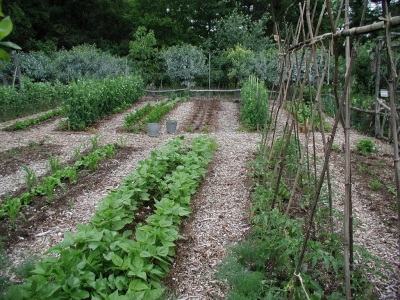
Studies over the past 15 or so years have documented a general decline in nutrients in our fruits and vegetables. Some people contend that our soils have been mined for their nutrients, worn out from poor farming, and therefore no longer able to provide us with nutritious food. The cure, according to these “experts,” is to sprinkle mineral-rich rock powders on the soil to replenish and rebalance that which has been lost. It all sounds very logical.
You might have sensed a big “but” looming. Here it is: But . . . further studies have pinned that nutrient decline on a dilution effect from increased yields. Pump up production with nitrogen fertilizer and water, or by breeding for increased yields, and nutrient concentrations decline; it’s as simple as that.
The final nail in the “worn out soil” coffin comes from side-by-side plantings of low- and high-yielding varieties of specific vegetables. The higher yielding varieties end up with lower concentrations of minerals and protein. The problem, then, if there is one, can be blamed on breeding and farming practices aimed at producing more bulk.
But . . .
I’m not concerned with nutrient decline in my own garden. First of all, I’ve chosen the varieties I grow — Blue Lake beans, Cherokee Purple tomatoes, Lincoln peas, Early Jersey Wakefield cabbage, Ashmead’s Kernel apple, and Fallgold raspberry, as examples — with
one thing in mind: flavor! 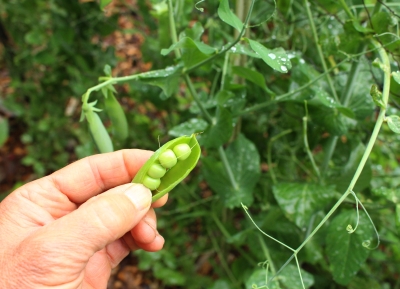 It just so happens that the most flavorful fruit and vegetable varieties are ones that have been around a long time. Yields may not be heavy, but these varieties are rich in flavor. (And perhaps nutrients. Anyway,
It just so happens that the most flavorful fruit and vegetable varieties are ones that have been around a long time. Yields may not be heavy, but these varieties are rich in flavor. (And perhaps nutrients. Anyway,
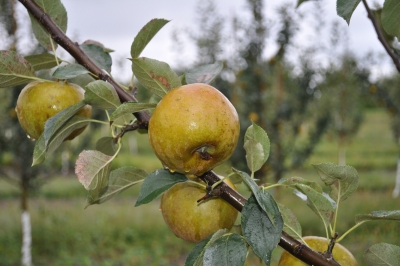
Ashmead’s Kernel apple
if something doesn’t taste that good, I’m not going to eat much of it, so it’s irrelevant how high it is in nutrients.)
I’m also not concerned with nutrient decline because I don’t push yields to the max with repeated applications of soluble, nitrogen-rich fertilizers. My soil management is simple: One inch of compost per year spread on top of the ground of permanent vegetable beds; compost, wood chips, hay, and/or leaves around my fruit plants. As these organic materials decompose, nitrogen and other essential nutrients are bled slowly into the soil only in response to warm temperatures and moisture, the same environment that spurs plant growth.

That compost is not serving up only nitrogen to my plants, or even just the big three nutrients, nitrogen, phosphorus, and potassium. Into my compost goes orange peels from Florida, avocado skins from California, and other kitchen waste, garden trimmings, some weedy hay, and, occasionally, horse manure. So the ground gets a wide variety of organic materials that, in turn, feed the compost and, in turn, feed the soil and the plants a wide spectrum of nutrients. And just to make sure that my soil lacks nothing, I occasionally sprinkle some powdered kelp around.
Herbs for Flavor, in Winter, Not Nutrition
Even if herbs were rich in nutrients, their nutritional contribution to our diets would be minimal because of the relatively small amounts actually eaten. But the small amounts needed to pizazz up a tomato sauce or frittata in winter also make herbs ideal for growing indoors in winter. A little goes a long way.
The basic problem is that many cooking herbs are Mediterranean plants that, of course, thrive best in Mediterranean conditions, with bright hot sun beating down on them. So the expectations and the reality of a windowsill herb garden often diverge. Forget about growing basil or oregano in January.
With that said, I nominate two herbs perfect for indoor growing in winter. The first is bay laurel. This plant, a small tree trained as a “standard,” has spent the last 29(!) winters near a sunny window. A freshly plucked leaf brings to soups and stews a flavor only hinted at by the dried leaf; to me, in addition to its distinctive flavor I sense an oleaginous quality hinting of olive oil.
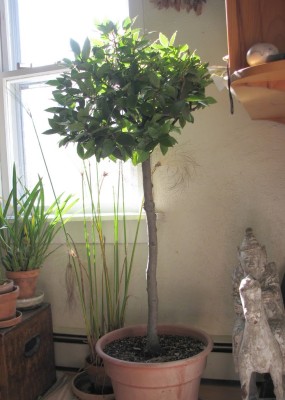
Bay laurel
The second herb, rosemary, is my favorite for indoor growing. Rosemary tolerates being trained as a standard or fanciful topiary; it looks equally good left to its own devices to grow as a relaxed, small shrub. (Mine are trained as standards.) Pinching off a few stem tips
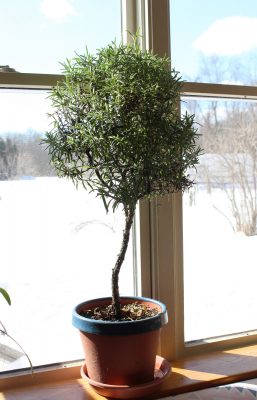
Small, indoor rosemary “tree”
with leaves not only puts some warm, Mediterranean sunshine into tomato sauce but also encourages growth of side shoots to keep the plant dense with shoots and leaves.
Once spring warmth has settled in around here, the bay laurel and rosemary will move outside to bask in the full force of Hudson Valley sunshine.



Lee:
What do you put on your Blueberries. Compost, etc? Any fertilizer otherwise?
What about Epsom Salts?
I used to use soybean meal (for nitrogen, mostly) topped by any weed free organic mulch such as wood shavings, leaves, sawdust, wood chips. After 30 years of doing this, all that organic matter has put quite a reserve of organic nitrogen in the soil so now all I do is mulch and, if needed, add sulfur to maintain a sufficiently acidic pH. The soil is blueberry heaven.
Lee:
I’ll try the soybean meal.
Thanks,
Good advice.
There are lots of herbs and figs and dwarf tropical fruits that can be brought indoors. My problem has always been that they bring the bugs with them. I used to bring my long seasoned hot peppers inside in the fall as well.
One day when I grow up I’m hoping to have a green house.
Lee, what is your trick to wintering rosemary? I have killed countless attempts. bright light, water, some harvesting, and then they go crisp and lifeless on me.
Stay tuned for tips on overwintering rosemary.
Move to Oregon – it doesn’t die over the winter here 🙂
Do you turn under the cover crops? Looks like they might be winter rye and field peas. I use the same two as cover crops over the winter and while the field peas die, the rye needs to be dug and turned over. (Big job!). Then covered with compost. Seems to fly against the ‘no dig’ theory. Any thoughts?
I grow oats or barley, either sometimes combined with peas, as cover crops. They winterkill and then flop down on the ground as mulch. Come spring, the tops are easy to lightly rake off, leaving the roots in place and not disturbing the soil at all.
Very nice summation.
Thank you.
I have never had a rosemary survive inside over the winter, either in a cool greenhouse, or in my kitchen. I know they need excellent drainage, therefore must not be over watered. Would you give some tips for growing them inside during winter?
Rosemary tips (on growing) soon to come.
Hi Lee– I greatly enjoy your blog! I have brought my rosemary inside for winter for several years, and have very good luck with it. (I am in western Mass, zone 5b) I keep it in a room that is pretty cold, with low light. I look forward to trying the bay laurel.
Also– I often dig up parsley in late fall (1st year plants), put them in a 5 gallon bucket with soil, and they too do great in the cool room with low light. This year I dug up chives as well, and put the pot on a fairly sunny windowsill. They died back after a time, but I kept them watered and now I have a lovely crop of fresh chives that remind me that spring will come eventually ! I have also had good luck with purchasing an organic basil plant from the grocery store in late summer or early fall. I transplant into a small self-watering planter, and remove 1/2-2/3 of the stems (these grocery store plants seem to be just a big bunch of seeds crowded in together in a small pot, so I thin it way down). Kept on a table next to a south window (not a greenhouse window, just a standard double pane window), I pinch the plants often and have lovely fresh basil for most of the winter and early spring. (Last year the plants got too scraggly around March but at the moment in late January, it still looks quite lush). They get very leggy, but the leaves are healthy and the plants fill out more as I keep pinching back. Worth a try! And thanks for your wonderful blog and website.
HI, Lee,
We met at the NOFA-NY winter conference two weekends ago.
I just read your blog on nutrition in vegetables, and believe there is another “but” which has to do with bug pressure on the vegetable plants. I recently saw a report of a controlled study that looked at simulating bug bites on strawberry leaves and testing the resulting berries for beneficial chemical content as compared with un-bitten controls. The study found a significant increase in the amount of these beneficial chemicals (which imbue flavor as well) in the experimental berries versus the controls.
This finding goes to the virtue of growing organically, without using pesticides. when the plants may need to mount a chemical defense against pest pressure which at the same time enhances the nutritional value of the plant.
Interesting, but not surprising. Can you tell me where you saw that study?